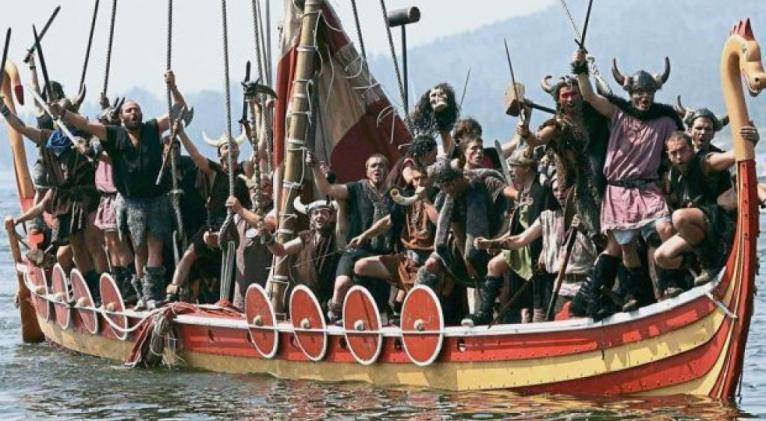The Viking survival guide to climate change
especiales

POPULAR culture has it that Vikings in their heyday loved to “go Viking” – take to their longships to rove, settle or pillage from North America to Asia.
But a driving force behind those Norse voyagers wasn’t just the lust for treasure or power or exploration. In some cases, it may have been climate change.
An international research team is looking into the environmental challenges – and, specifically, a change in sea level – that appear to have pushed some Vikings living in the Lofoten Islands along the northern coast of Norway to abandon their boathouses and relocate to another part of the coast.
“There’s a lot of research looking at Viking civilisation and, in particular, their expansion and impacts on other parts of the world,” said paleoclimatologist Nick Balascio of the College of William and Mary in Williamsburg. “But our research is really looking at the paeloenvironmental aspects of this – or how environmental changes may have influenced their society and, in particular, during this important period of development.”
The period is known as the Viking Age, roughly 800 A.D. to 1050 A.D., which overlaps the tail end of the Iron Age.
Balascio is part of a team of archaeologists, climate scientists and students studying what remains of some of those coastal settlements by extracting core samples from the bottoms of glacial lakes. Their work is an extension of his previous research to understand past natural climate fluctuations.
While climate change today consists of ever-warming average global temperatures and rising sea levels, the Vikings were faced with quite the opposite. Because their landmass had been much closer to the ancient glaciers, ice melt over previous millennia meant the land, freed from all that weight, was rising. And land rebound meant the shoreline that the seafarers relied on for fishing, trade and transportation was receding. As sea level change began to affect harbor access, Balascio said, Viking chieftains needed to figure out how to adapt. The research team is still working through data collected so far, he said, but there’s some evidence that the Norsemen did move toward the sea as it receded.
“In cases where the rebound was occurring at certain harbors, (they were) almost completely abandoning them and moving to significantly different parts of the region for the new harbor locations,” Balascio said. “What we’re trying to do is look in detail at the timing of those changes to see if we can see any lag between the changing of the locations or what the impact could have been on the people, whether it’s culturally or politically.”
It’s unclear if environmental changes were the primary driver for resettlement, but researchers are fairly certain those changes did have a regional impact. Still, they caution against drawing too straight a line.
At the end of the Iron Age, Vikings living in the rugged Lofoten archipelago, located above the Arctic Circle, were already facing tough environmental challenges, said research partner Stephen Wickler of the Department of Cultural Sciences at the Tromso University Museum in Norway.
“Marginal agricultural conditions, with difficulty in obtaining fodder for livestock and crop failures for cereal production,” Wickler explained. “Unstable weather patterns exacerbated by the offshore location (and) extreme maritime conditions.”
As such, he said, it’s extremely difficult to pin down causality attributable to past climate change.
“It seems to be a fashionable trend to single out climate change as a prime mover for the transformation of past societies – something that I find highly speculative and, in many cases, unwarranted,” Wickler said.
Still, climate change can be one of many factors contributing to changes in that late Iron Age society, he said, and “there is evidence for environmental factors leading to tipping points where significant change did occur in a short space of time.”
Shrinking coastlines stranded valuable harbors and fishing boats. Bays were left isolated, and drainage from rivers formed “freshwater lenses” on the surfaces, allowing the surface water to freeze in winter, said research partner William D’Andrea from the Lamont-Doherty Earth Observatory of Columbia University.
While the island fishermen and farmers were living in an extreme, marginal environment, D’Andrea said, luckily they were also part of a large-scale trading system and likely had “a number of economic strategies that insulated them from feeling the full impacts of the changes in local climate.”
According to Balascio, they are looking for evidence of any and all human activity that might have washed in from the watershed – signs of deforestation, slash-and-burn practices, farming, cooking pits – in the sediment the deepest parts of glacial lakes. The data is preliminary so far, he added, but in the next year they hope to have more definitive and detailed evidence of human presence before, during and after the Iron and Viking ages.
D’Andrea cautioned that it’s premature to speculate or extrapolate too much about how the island Vikings responded to a changing climate.
“However, remember that in response to climate changes and economic pressure, they would have been able to move into new territory that was often unpopulated or underpopulated -- this strategy would not work on our planet today,” he said.
“I’ll also say that the climate changes that the Iron Age Vikings dealt with were modest compared to those that society is facing now and that we will be facing in the coming decades.”
Balascio agreed that the Lofoten Viking experience isn’t directly comparable to today, when human activity is changing the climate at an accelerating pace.
But the research does offer a better perspective on how people of the past responded to climate and environmental changes.
“In general,” Balascio said, “I’m optimistic that humans are resilient.”













Add new comment